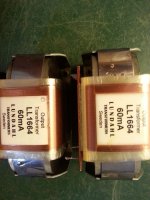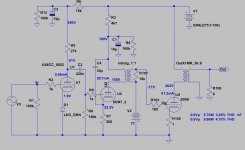Not all led sound good I think that depend of the brand or type since SiC or HER207 diodes are very stables with very good sound too, have you check diodes ?My daily (from 6-7 years) amplifier has cascode DN2540 CCS (12mA) loaded trioded D3a as VAS stage (+ V-Cap coupled FET source follower, DC to 300B SE, 5k:8 OPT).
2V (green) LED bias is atom stable, the sound is natural and crystal clear.
Any R//C bias (I have some handfull of Shinkoh tantalum resistors, Blackgate and Elna Cerafine capacitors, so tried some variations) is degrades the sound.
In my MM phono stage (passive circuit between two stage Raytheon black plate 5751, Tungsram ECC82 CF) I use LED bias (first two stages, 1mA current, green LEDs). I developed and built several phono stages, but it is the best and absolute noisless.
I use -at least- 30 years old 5mm red and green (mostly gallium arsenide) LEDs. In my experience these give better "sound" than "modern" LEDs.
I have some Cree SiC diodes (I use these in HV supply circuits). I tried its as bias diodes (2-3 SiC diode in one LED's place), but only in the 25-100mA region. Good devices, at higher cost and occupies more space.
I have some Cree SiC diodes (I use these in HV supply circuits). I tried its as bias diodes (2-3 SiC diode in one LED's place), but only in the 25-100mA region. Good devices, at higher cost and occupies more space.
When the led is correct I agree that sound are better than R-C biasing ( silmic II include ), But how to know if the led is the good or the ugly, We need to look for NOS led diodes 🙂,
HLMP-6000 is not available anymore (but if someone wants to sell me some...🙂). I'll take HLMP-1301 instead.
I've always used the HLMP-6000, which is what Bottlehead use in a lot of their kits.
6GF7/300B amp V.2
Hi. This is my second version of 6GF7/300B amp. I had too much gain keeping the high µ triode (68) therefore I replace the input tube for a 6922 (µ=33) and made some changes also.
OPERATING POINT:
6922: 90V, 6mA, -2.2V
6GF7 low µ: 160V, 42mA, -24V
300B: 350V, 60mA, -74V
Hi. This is my second version of 6GF7/300B amp. I had too much gain keeping the high µ triode (68) therefore I replace the input tube for a 6922 (µ=33) and made some changes also.
OPERATING POINT:
6922: 90V, 6mA, -2.2V
6GF7 low µ: 160V, 42mA, -24V
300B: 350V, 60mA, -74V
Attachments
Had under blanket sound, I could not fix it with added foil caps.Yes, a resistor of 2.2V/6mA = 366Ohms will do the job, with much less noise. Use a 330 or 390Ohms, and parallel to it suitable cap value as a function of the lower frequency you want the amplifier respond.
Unbypassed+fet is much better. Gain is bigger than any plate resistor...
Hi. This is my second version of 6GF7/300B amp.
In my opinion there are two critical point in the schematic.
6EM7 cathode bias voltage is the limiting value. If you want more power (over A1 region), the first stage peek voltage would exceed, so you push 6EM7 to A2 region (distortion will increase).
The second possible bottleneck is the interstage HF bump. It's reducible with powerful loading (R, or R and C snubber) of secondary, but it reacts to primary side too.
If you have good interstage for low Rp tubes, with high primary current, why not use trioded D3a or C3g as VAS and driver?
Attachments
OMG! Thanks for spice simulation and comments!
I realized the LED model (HLMP1301) should be indicated instead of 1.9V because the bias voltage is 2.2V: operating point is not the same. But adding a 51R under 6mA it's okay (1.9V + 0.3V).
The LL1664 are 3k:8. Not the same output and distorsion but no big deal here...
The IT winder personal preference is a high load resistor (30k-150k) but it's not critical without any (distortion is low and copper losses too).
D3a and C3m in triode mode seem to be very linear and have a good swing (at least D3a) but not plenty of those tubes around here...Also, 1.2k rp max would be better if I want god performance with IT.
Thanks again!
I realized the LED model (HLMP1301) should be indicated instead of 1.9V because the bias voltage is 2.2V: operating point is not the same. But adding a 51R under 6mA it's okay (1.9V + 0.3V).
The LL1664 are 3k:8. Not the same output and distorsion but no big deal here...
The IT winder personal preference is a high load resistor (30k-150k) but it's not critical without any (distortion is low and copper losses too).
D3a and C3m in triode mode seem to be very linear and have a good swing (at least D3a) but not plenty of those tubes around here...Also, 1.2k rp max would be better if I want god performance with IT.
Thanks again!
In my opinion there are two critical point in the schematic.
6EM7 cathode bias voltage is the limiting value. If you want more power (over A1 region), the first stage peek voltage would exceed, so you push 6EM7 to A2 region (distortion will increase).
The second possible bottleneck is the interstage HF bump. It's reducible with powerful loading (R, or R and C snubber) of secondary, but it reacts to primary side too.
If you have good interstage for low Rp tubes, with high primary current, why not use trioded D3a or C3g as VAS and driver?
Attachments
IMHO (300B) mixed -fix and cathode- bias is the worst scenario. The 200R is unnecessary.
Cathode bias is safe, but must use very good high (200-350V) voltage -for example BG VK- blocking capacitor.
Cathode bias is safe, but must use very good high (200-350V) voltage -for example BG VK- blocking capacitor.
OMG! I realized the LED model (HLMP1301) should be indicated instead of 1.9V because the bias voltage is 2.2V: operating point is not the same. But adding a 51R under 6mA it's okay (1.9V + 0.3V).
Instead of resistor try simple diode with low forward voltage.
IMHO (300B) mixed -fix and cathode- bias is the worst scenario. The 200R is unnecessary.
Cathode bias is safe, but must use very good high (200-350V) voltage -for example BG VK- blocking capacitor.
"combination bias". This is Eli Duttman's advice. He's using 150R on cathode (300B) if I do remember. The idea is not bad to avoid "runaway" problem with some DHT and give some "stabilization" for 300B (light local NFB).
Totally agree. I didn't find 2.2V "good old" LED (germanium) yet.
Instead of resistor try simple diode with low forward voltage.
- Status
- Not open for further replies.
- Home
- Amplifiers
- Tubes / Valves
- 6GF7 and 300B amp



